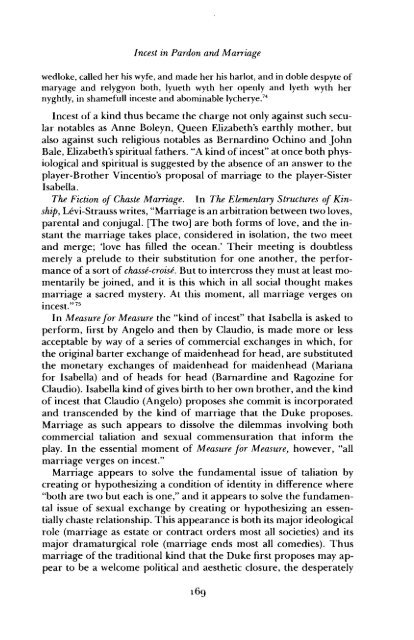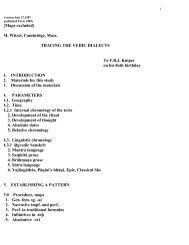Incest in Pardon and Marriage - People Fas Harvard
Incest in Pardon and Marriage - People Fas Harvard
Incest in Pardon and Marriage - People Fas Harvard
Create successful ePaper yourself
Turn your PDF publications into a flip-book with our unique Google optimized e-Paper software.
<strong>Incest</strong> <strong>in</strong> <strong>Pardon</strong> <strong>and</strong> <strong>Marriage</strong><br />
wedloke, called her his wyfe, <strong>and</strong> made her his harlot, <strong>and</strong> <strong>in</strong> doble despyte of<br />
maryage <strong>and</strong> relygyon both, lyueth wyth her openly <strong>and</strong> lyeth wyth her<br />
nyghtly, <strong>in</strong> shamefull iriceste <strong>and</strong> abom<strong>in</strong>able ly~herye.'~<br />
<strong>Incest</strong> of a k<strong>in</strong>d thus became the charge not only aga<strong>in</strong>st such secu-<br />
lar notables as Anne Boleyn, Queen Elizabeth's earthly mother, but<br />
also aga<strong>in</strong>st such religious notables as Bernard<strong>in</strong>o Och<strong>in</strong>o <strong>and</strong> John<br />
Bale, Elizabeth's spiritual fathers. "A k<strong>in</strong>d of <strong>in</strong>cest" at once both phys-<br />
iological <strong>and</strong> spiritual is suggested by the absence of an answer to the<br />
player-Brother V<strong>in</strong>centio's proposal of marriage to the player-Sister<br />
Isabella.<br />
The Fiction of Chaste <strong>Marriage</strong>. In The Elementary Structures of K<strong>in</strong>-<br />
ship, Levi-Strauss writes, "<strong>Marriage</strong> is an arbitration between two loves,<br />
parental <strong>and</strong> conjugal. [The two] are both forms of love, <strong>and</strong> the <strong>in</strong>-<br />
stant the marriage takes place, considered <strong>in</strong> isolation, the two meet<br />
<strong>and</strong> merge; 'love has filled the ocean.' Their meet<strong>in</strong>g is doubtless<br />
merely a prelude to their substitution for one another, the perfor-<br />
mance of a sort of chase'-croise'. But to <strong>in</strong>tercross they must at least mo-<br />
mentarily be jo<strong>in</strong>ed, <strong>and</strong> it is this which <strong>in</strong> all social thought makes<br />
marriage a sacred mystery. At this moment, all marriage verges on<br />
<strong>in</strong>cest." 75<br />
In Measure for Measure the "k<strong>in</strong>d of <strong>in</strong>cest" that Isabella is asked to<br />
perform, first by Angelo <strong>and</strong> then by Claudio, is made more or less<br />
acceptable by way of a series of commercial exchanges <strong>in</strong> which, for<br />
the orig<strong>in</strong>al barter exchange of maidenhead for head, are substituted<br />
the monetary exchanges of maidenhead for maidenhead (Mariana<br />
for Isabella) <strong>and</strong> of heads for head (Barnard<strong>in</strong>e <strong>and</strong> Ragoz<strong>in</strong>e for<br />
Claudio). Isabella k<strong>in</strong>d of gives birth to her own brother, <strong>and</strong> the k<strong>in</strong>d<br />
of <strong>in</strong>cest that Claudio (Angelo) proposes she commit is <strong>in</strong>corporated<br />
<strong>and</strong> transcended by the k<strong>in</strong>d of marriage that the Duke proposes.<br />
<strong>Marriage</strong> as such appears to dissolve the dilemmas <strong>in</strong>volv<strong>in</strong>g both<br />
commercial taliation <strong>and</strong> sexual commensuration that <strong>in</strong>form the<br />
play. In the essential moment of Measure for Measure, however, "all<br />
marriage verges on <strong>in</strong>cest."<br />
<strong>Marriage</strong> appears to solve the fundamental issue of taliation by<br />
creat<strong>in</strong>g or hypothesiz<strong>in</strong>g a condition of identity <strong>in</strong> difference where<br />
"both are two but each is one," <strong>and</strong> it appears to solve the fundamen-<br />
tal issue of sexual exchange by creat<strong>in</strong>g or hypothesiz<strong>in</strong>g an essen-<br />
tially chaste relationship. This appearance is both its major ideological<br />
role (marriage as estate or contract orders most all societies) <strong>and</strong> its<br />
major dramaturgical role (marriage ends most all comedies). Thus<br />
marriage of the traditional k<strong>in</strong>d that the Duke first proposes may ap-<br />
pear to be a welcome political <strong>and</strong> aesthetic closure, the desperately
















